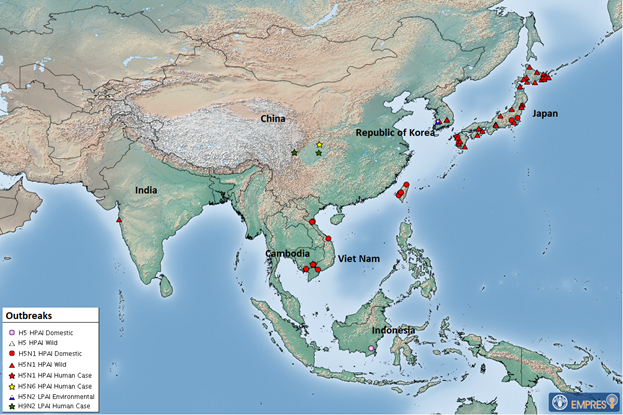The following article is based on a summary provided by Kamata Akiko from the FAO Animal Production and Health division (NSAH):
FAO/EMPRES-AH consistently monitors the global avian influenza situation, gathering information from various national and international sources and peer-reviewed scientific articles. Through close collaboration with country and regional offices, the implementation of avian influenza field surveillance projects, and networks of expertise such as WOAH/FAO’s OFFLU (www.offlu.org), timely information on outbreaks, surveillance findings, and genetic similarities of circulating viruses or their virological features is made accessible. This information is stored in the EMPRES Global Animal Disease Information System (EMPRES-i), a database available online at https://empres-i.apps.fao.org/.

Between September 3 and December 2, 2023, three distinct subtypes of avian influenza virus were reported in East and South-East Asia. Among these, only H5N1 or H5 were confirmed to be highly pathogenic in poultry. ©EMPRES-I
In September, India reported one H5N1 HPAI event in Black Swans and Silver pheasants in a national park in Maharashtra State. The Republic of Korea reported 39 LPAI events in 8 out of 17 provinces, including 35 H5N3 LPAI, one H5N2 LPAI, and two H5 LPAI events in captured or dead wild birds and their droppings — and since November 27, three H5N1 HPAI events in captured or dead wild birds in North Jeolla and North Gyeongsang provinces, and one H5N1 HPAI outbreak on a duck farm in South Jeolla Province. Since October 4, Japan reported 52 events of H5N1 HPAI in 13 out of 47 prefectures among various bird species (e.g., Anatidae, eastern buzzard, eastern spot-billed duck, Eurasian teal, Eurasian wigeon, hooded crane, large-billed crow, mountain hawk-eagle, peregrine falcon, red-crowned crane, Tundra swan, whooper swan, a captive falcon, and its prey) and environmental samples, including water samples from the Izumi Wintering Habitat of Cranes. Since November 24, four H5N1 HPAI outbreaks in layer chickens in four prefectures. China reported one detection of H5N1 HPAI in environmental samples collected from Sihcao Wetland in Tainan City on November 18, along with five outbreaks of H5N1 HPAI in poultry in Tainan City, Chiayi, Miaoli, Yunlin counties, and one detection at a slaughterhouse in Taipei City in Taiwan Province. Indonesia reported an unspecified subtype of HPAI outbreak during September-October. Viet Nam officially reported HPAI outbreaks in domestic birds in Binh Duong, Long An, and Quang Nam provinces, also detecting H5N1 in two markets in Nghe An Province. In Cambodia, a total of four H5N1 HPAI outbreaks in village poultry were reported in Prey Veng and Svay Rieng provinces in October, and in Kampot Province in November.
Meanwhile, three cases of human infection with influenza A(H5N1) virus were reported from Cambodia in Prey Veng and Svay Rieng provinces in October and Kampot Province in November. China also reported one case of A(H5N6) in Chongqing in September and one case of A(H9N2) in Sichuan in October.
Highly pathogenic H5Nx viruses have demonstrated the ability to spread via migratory water birds. During this period, H5N1 HPAI events have also been reported in wild birds near Antarctica, namely among brown skua in South Georgia and the South Sandwich Islands, and southern fulmar and black-browed albatross in the Falkland Islands (Malvinas).
We consider avian influenza activity in the East Asia flyway area to have increased during this period, so reports of outbreaks in poultry and detections in wild birds and some mammal species are expected to increase over the coming months in the region. The list of bird species affected by H5Nx HPAI globally is available HERE with the new species reported since 2021 highlighted in orange.




